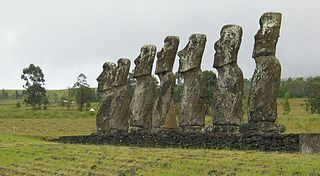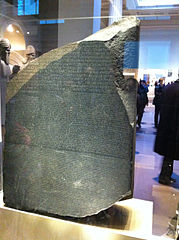The discoveries of Easter Island and the Rosetta Stone were two major finds in the 18th century. These discoveries would end the isolation of two separate cultures, the Rapa Nui and the ancient Egyptians. The discovery of Easter Island exposed its inhabitants, the Rapa Nui, to the world. The Rosetta Stone helped scholars break the code of the hieroglyphic writings of ancient Egypt, thus allowing scholars to learn about ancient Egyptian life and culture.
Easter Island

Picture taken by Bjarte Sorensen Creative Commons: by-sa
On Easter Sunday, April 5, 1722, Dutch explorer Jacob Roggeveen discovered Easter Island, ending 1400 years of isolation for the island's inhabitants who called themselves the Rapa Nui. The islanders were so isolated that they had never known of the existence of other people because, according to Roggeveen, the islanders' canoes were not capable of crossing the ocean.
His first impression of the island was not of a paradise but of a wasteland. Roggeveen states that "We originally, from a further distance, have considered the said Easter Island as sandy; the reason for that is this, that we counted as sand the withered grass, hay, or other scorched and burnt vegetation because its wasted appearance could give no other impression than of singular poverty and barrenness."
When Roggeveen and his crew explored the island, they found massive stone statues in various stages of construction. "The stone images at first caused us to be struck with astonishment," Roggeveen wrote, "because we could not comprehend how it was possible that these people, who are devoid of heavy thick timber for making any machines, as well as strong ropes, nevertheless had been able to erect such images." (1)
Other European explorers would soon come to the island. The Spanish, led by Don Felipe Gonzalez de Haedo, came in 1770 and claimed the island for King Charles III. James Cook, during his second voyage in the Pacific, briefly visited the island.
These 18th-century European contacts put the island on the map but it would have catastrophic effects on the island society throughout the 19th century.
The Rosetta Stone

By McKay Savage from London, UK
[CC-BY-2.0], via Wikimedia Commons
In July 1779, Pierre François Xavier Bouchard discovered the Rosetta Stone while he and others of the French army were working on extending Fort Julien in the village of Rashid (known as Rosetta to Europeans) located a few miles from the sea in the western delta of the Nile.
The black basalt stone had three different languages chiseled on it. At the top was the hieroglyphics of ancient Egypt, in the middle was Egyptian Demotic script and the bottom was the ancient Greek language. Since Ancient Greek was a known language at the time, translation was easy. The Greek text was a royal edict issued on March 27, 196 B.C that recorded the benefits conferred on Egypt by the 13-year-old pharaoh Ptolemy V. (1)
In September 1799, an article published in the Courrier de l'Egypte made the public aware of the discovery and scholars quickly learned that this stone was the key to deciphering the ancient Egyptian language. The French transported the stone to Cairo, where Jean-Joseph Marcel and Remi Raige were able to identify the middle script as Demotic. They made copies of the inscriptions and distributed them to scholars throughout Europe, so they could work on breaking the code of the ancient language.
Scholars concentrated on deciphering the Demotic script because it looked more like letters than pictures. The first scholar to make headway in deciphering this script was Johann Akerblad, who had knowledge of the Coptic language. He was able to identify the words for love, temple, and Greek. The French scholar De Sacy, in 1802, identified the symbols that represented Ptolemy and Alexander. This confirmed that Demotic script was a phonetic script and, therefore translatable. (2)
The British scholar Thomas Young determined that the other writings said the same thing. By looking at the cartouches (a circled set of hieroglyphs)he discovered that they represented the name, Ptolemy. He also noticed that this name repeatedly showed up in the Demotic language in the same position as it did the Greek. He also noticed that the same cartouche was also repeated the same number of times. He hypothesized that the hieroglyphs were actually phonetic symbols and that they could be read by studying the direction in which the symbols were facing. In 1824, he described his findings in the Encyclopedia Britannica.
The French linguist Jean-Francois Champollion, by drawing upon the work done by previous scholars, accurately and completely translated the hieroglyphs and published his findings in 1822. (4)
